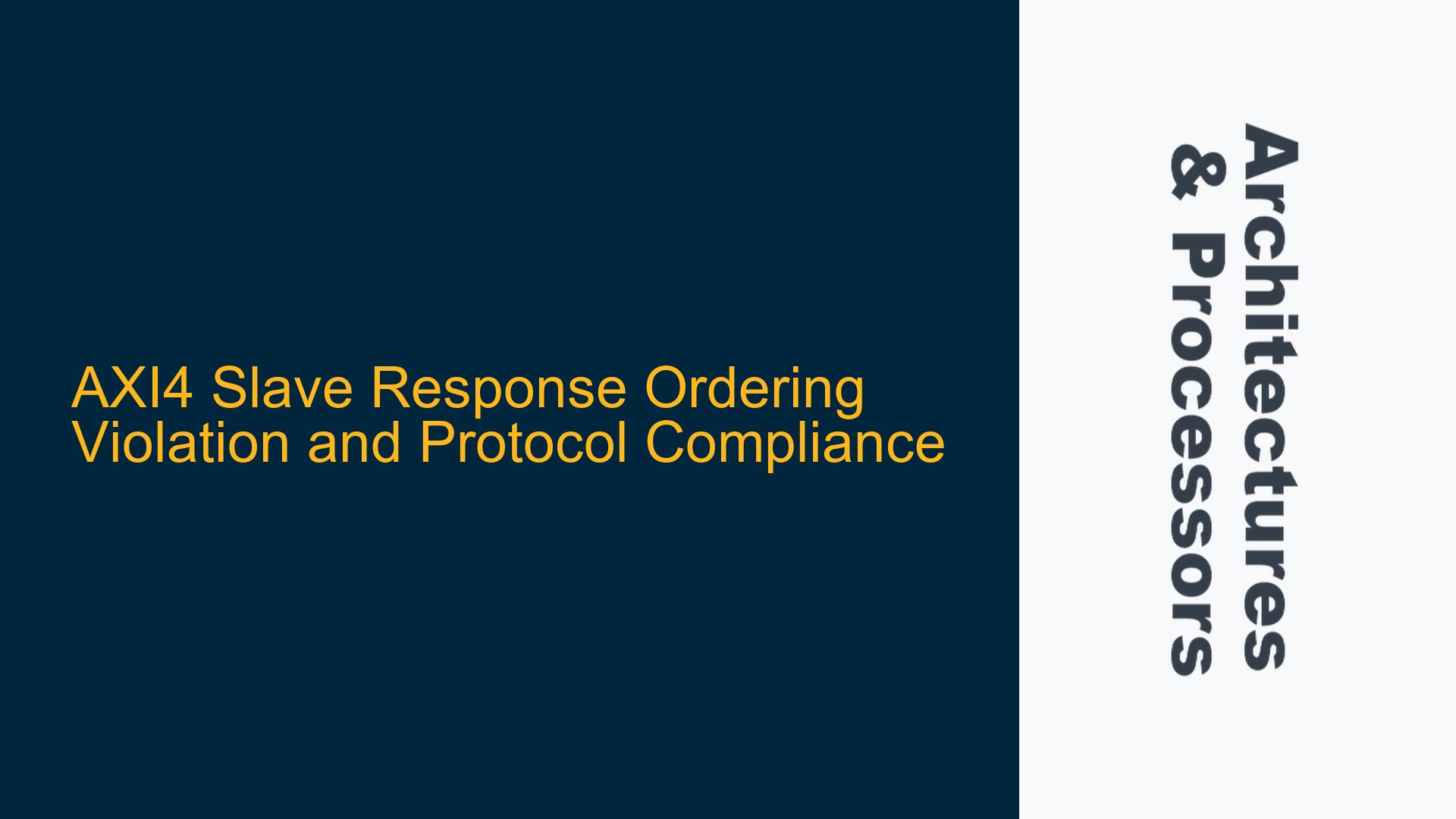AXI4 Slave Response Ordering Requirements and Protocol Violations
The AXI4 protocol, as defined in the ARM AMBA specification, imposes strict requirements on the ordering of responses from slaves to ensure proper functionality and predictability in multi-master, multi-slave systems. The protocol mandates that responses for transactions with the same ID must be returned in the order they were issued. This requirement is critical for maintaining coherency and ensuring that the master can correctly interpret the responses it receives. In the scenario described, the slave attempts to reorder responses for transactions with the same ID (ARID=4), which directly violates the AXI4 protocol. Specifically, the slave generates responses out of order for transactions with ARID=4, leading to potential misinterpretation by the master.
The AXI4 protocol allows for reordering of responses only for transactions with different IDs. This flexibility is intended to optimize performance by enabling slaves to process transactions in parallel or out of order when possible. However, this flexibility does not extend to transactions with the same ID. For transactions with the same ID, the protocol enforces strict ordering to ensure that the master can correctly associate each response with the corresponding transaction. This is particularly important in systems where multiple transactions with the same ID are issued in sequence, as the master relies on the order of responses to maintain coherency and correctness.
In the example provided, the slave generates responses in the following order: 4th transaction (ARID=4, ARLEN=3), 1st transaction (ARID=4, ARLEN=10), 3rd transaction (ARID=5, ARLEN=18), and 2nd transaction (ARID=4, ARLEN=3). This sequence violates the AXI4 protocol because the response for the 4th transaction (ARID=4) is generated before the responses for the 1st and 2nd transactions (also ARID=4). The master, upon receiving the response for the 4th transaction first, would incorrectly interpret it as the response for the 1st transaction, leading to data corruption or system failure.
The protocol violation in this scenario highlights the importance of implementing proper response ordering logic in the slave. The slave must ensure that responses for transactions with the same ID are returned in the order they were issued. This requirement is not optional; it is a fundamental aspect of the AXI4 protocol that must be adhered to for correct system operation.
Root Causes of AXI4 Slave Response Ordering Violations
The root cause of the response ordering violation in the described scenario lies in the slave’s failure to implement the necessary logic to enforce the AXI4 protocol’s ordering requirements. Specifically, the slave lacks the mechanisms to track the order of transactions with the same ID and ensure that responses are generated in the correct sequence. This failure can be attributed to several factors, including insufficient understanding of the AXI4 protocol, inadequate design practices, or incorrect assumptions about the behavior of the master and interconnect.
One possible cause of the violation is the slave’s attempt to optimize performance by reordering responses without considering the protocol’s constraints. While reordering responses for transactions with different IDs can improve performance, doing so for transactions with the same ID is strictly prohibited. The slave must prioritize protocol compliance over performance optimizations in this context. Another potential cause is the absence of a robust transaction tracking mechanism in the slave. The slave must maintain a record of the order in which transactions with the same ID are received and ensure that responses are generated in the same order.
Additionally, the violation may result from incorrect assumptions about the behavior of the master and interconnect. The slave may assume that the master or interconnect will handle response ordering, leading to a lack of proper ordering logic in the slave itself. However, the AXI4 protocol places the responsibility for response ordering on the slave, and the master and interconnect rely on the slave to adhere to the protocol’s requirements. Failure to implement the necessary logic in the slave can lead to protocol violations and system failures.
The violation may also stem from a misunderstanding of the AXI4 protocol’s requirements regarding transaction IDs. The protocol uses transaction IDs to differentiate between transactions and enforce ordering constraints. Transactions with the same ID must be processed in the order they were issued, while transactions with different IDs can be reordered. The slave must correctly interpret and enforce these requirements to ensure protocol compliance.
Implementing AXI4 Slave Response Ordering Logic and Ensuring Protocol Compliance
To address the response ordering violation and ensure compliance with the AXI4 protocol, the slave must implement robust response ordering logic. This logic must track the order of transactions with the same ID and ensure that responses are generated in the correct sequence. The following steps outline the necessary actions to achieve this:
-
Transaction Tracking Mechanism: The slave must implement a transaction tracking mechanism to record the order in which transactions with the same ID are received. This mechanism can be implemented using a queue or FIFO structure that stores transaction details, including the transaction ID, address, and length. The slave must ensure that responses are generated in the same order as the transactions are received.
-
Response Generation Logic: The slave must implement response generation logic that enforces the AXI4 protocol’s ordering requirements. This logic must ensure that responses for transactions with the same ID are generated in the order they were issued. The logic must also handle cases where transactions with different IDs are processed in parallel, allowing for reordering of responses for transactions with different IDs.
-
Protocol Compliance Checks: The slave must include protocol compliance checks to verify that responses are generated in accordance with the AXI4 protocol’s requirements. These checks can be implemented using assertions or formal verification techniques to ensure that the slave’s behavior adheres to the protocol. The checks must verify that responses for transactions with the same ID are generated in the correct order and that responses for transactions with different IDs can be reordered.
-
Performance Optimization Considerations: While the slave must prioritize protocol compliance, it can also implement performance optimizations within the constraints of the AXI4 protocol. For example, the slave can process transactions with different IDs in parallel and reorder their responses to improve performance. However, the slave must ensure that these optimizations do not violate the protocol’s ordering requirements for transactions with the same ID.
-
Verification and Testing: The slave’s response ordering logic must be thoroughly verified and tested to ensure compliance with the AXI4 protocol. This verification can be performed using simulation, formal verification, and hardware testing. The verification process must include test cases that cover various scenarios, including transactions with the same ID, transactions with different IDs, and mixed sequences of transactions. The test cases must verify that the slave generates responses in the correct order and adheres to the protocol’s requirements.
By implementing these steps, the slave can ensure compliance with the AXI4 protocol’s response ordering requirements and avoid the violations described in the scenario. The slave must prioritize protocol compliance over performance optimizations and implement robust transaction tracking and response generation logic to ensure correct system operation.
In conclusion, the AXI4 protocol’s response ordering requirements are critical for maintaining coherency and correctness in multi-master, multi-slave systems. The slave must implement robust response ordering logic to ensure that responses for transactions with the same ID are generated in the order they were issued. Failure to adhere to these requirements can lead to protocol violations, data corruption, and system failures. By following the outlined steps, the slave can achieve compliance with the AXI4 protocol and ensure correct system operation.






